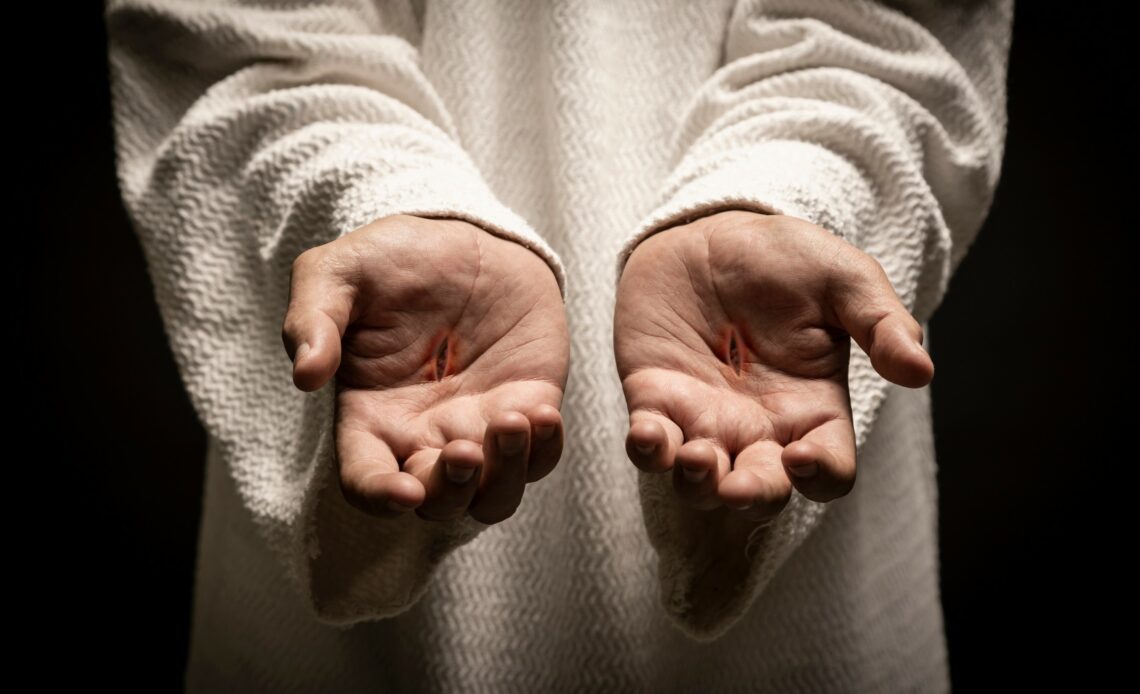“But he was wounded for our transgressions, he was bruised for our iniquities: the chastisement of our peace was upon him; and with his stripes we are healed” (KJV, Is. 53:5).
“But he was wounded”
Isaiah 53:5 shouts with the responding theme of substitution. But before the reader arrives, he is told Christ was wounded. The Hebrew word translated as wounded is chalal which also carries the meaning of boring, which is likely where many of the modern translations derive the word piercing from in saying that Christ was pierced.
The wounding and piercing of Christ is a clear claim of the Scriptures. Zechariah says, “And one shall say unto him, What are these wounds in thine hands? Then he shall answer, Those with which I was wounded in the house of my friends” (Zech. 13:6). Christ would come and be wounded by the ones He came to save, His Jewish companions.
Elsewhere the Bible tells the reader of the prophecies coming to pass, “And when they had crucified him, they parted his garments, casting lots upon them, what every man should take. And it was the third hour, and they crucified him” (Mark 15:24-25). All four of the Gospel accounts tell the reader that Christ was crucified and died as a result.
But why?
“for our transgressions”
Isaiah tells the reader that Christ was crucified for the sake of others to be healed. He died for the transgressions of the people. Throughout the Old Testament, God was preparing His people for the substitutionary act of Christ. In the law of Moses, animal sacrifices were instituted to display God’s design and desire for substitution to bring about atonement.
During the Day of Atonement, the great high priest would lay his hands on the head of a live goat and send it out into the wilderness. Then, the second goat would be killed, and the blood would be sprinkled on the mercy seat and before the mercy seat. Thus the goat’s life would be given for the life of the people.
However, the book of Hebrews tells the reader that the blood of goats and bulls could never atone for sin. Instead, the Bible says, “For all have sinned, and come short of the glory of God; Being justified freely by his grace through the redemption that is in Christ Jesus: Whom God hath set forth to be a propitiation through faith in his blood, to declare his righteousness for the remission of sins that are past, through the forbearance of God” (Rom. 3:23-25). In other words, everyone has sinned and needs forgiveness. God overlooked the people’s sins in the Old Testament, but they were never paid for. Isaiah foresaw a time when the people’s sins would be atoned for in Jesus Christ.
“he was bruised”
Yet again, Isaiah speaks of the treatment of the Servant of the Most High. First, Isaiah tells the reader of the wounding of Christ. Next, he tells of the bruising. The Hebrew word that is translated as bruised is daka. The word daka can mean to bruise, crumble, destroy, crush, and even beat and break into pieces.
But the astonishing reality is that it was the will of the Lord to crush the servant. Despite the fact Jesus received wounds in the house of His friends, it was the sovereign will of God to bruise the Son as the substitute for mankind. Jeremiah’s words found their resting place in Isaiah’s prophecy when he said, “For the Lord will not cast off for ever: But though he cause grief, yet will he have compassion according to the multitude of his mercies. For he doth not afflict willingly nor grieve the children of men. To crush under his feet all the prisoners of the earth” (Lam. 3:31-33). Daka is translated as crush in Lamentations 3:33.
God does not crush all the prisoners of the earth under his feet. Instead, He has crushed the Son in their place.
“for our iniquities”
Jesus Christ was crushed for the iniquities of man. The Son of God took on flesh and dwelt among His creation two thousand years ago. He was one hundred percent God and one hundred percent man. He did not give up any of His attributes when He came to the earth; instead, the fullness of God dwelt in Him bodily.
Jesus, the Servant of the Father, lived a perfect life under the law of God. He was innocent, and in His death, He did not have any of His own sins to atone for so He could pay for another’s. Furthermore, He came not to be served but to serve and therefore laid His life down for the sake of others. Finally, being the God-man, His worth was more significant than all of creation; therefore, in His death, He could pay for the salvation of those Who would come to Him in faith and repentance.
A bull or goat could not die in place of man and entirely pay for his sin because they were not of equal value as one created in the image of God. The death of the Son of God tips the scales in the opposite direction because of His infinite worth.
“the chastisement”
Here the reader is introduced to the third descriptive word concerning the treatment of Christ. He was bruised, wounded, and chastised. To say that Jesus was chastised is to say that Jesus took upon Himself the punishment of man. Man had sinned and was deserving of punishment. The Bible declares that the wages of sin is death. Thus, sin deserves death. But Christ came and died in the place of sinful man, taking the punishment that man deserves.
“of our peace was upon him”
Yet again, the reader is told of the substitutionary death of Christ. For there to be peace with God, Christ had to come and suffer. Paul tells the reader of the universality of sin in the book of Romans. The world had gone astray, and nobody was seeking after God. Amid this reality, God sent His Son into the world. He kept true to His promise never to flood the world again. Instead, He provided a redeemer. As the rainbow shoots an arrow up to God as the solution to the sin problem, the cross tells of how He did it.
The unbeliever is at odds with God, whether he knows it or not. Nevertheless, God has made a way for man to be made right with Him apart from the law. Jesus Christ was punished on the cross so that man could be healed and at peace with God. God has always desired peace between Himself and His creation. He walked with man in the Garden. He set up His tabernacle among the children of Israel. Finally, He sent His Son to walk among the people again and die so they might live.
“and with his stripes we are healed”
The stripes of Christ are healing stripes. Peter tells of their work in the life of the Christian. Peter says, “Who his own self bare our sins in his own body on the tree, that we, being dead to sins, should live unto righteousness: by whose stripes ye were healed” (1 Pet. 2:23). Jesus Christ bore the sins of many so that the Christian would die to sin and live to righteousness.
What does it mean that the wounds of Christ healed the Christian? Peter tells the reader that it is more than forgiveness. It is transformation. Through the death of Christ, the believer dies to sin and is therefore enabled to live a righteous life.
But how does this take place? Apart from being at peace with God, there is no hope of a righteous life. But when one dies with Christ, his old nature is punished in Christ and dies on the cross. Thus, there is no animosity between God and man anymore, and the believer can receive all the rich benefits of being on good terms with His creator. By the wounds of Christ, the believer is healed.
Final prayer
Father, I thank You for the work of Christ and His substitutionary death for me. I do not deserve His love and attention, but I thank You for giving it. In Jesus’ name, Amen.


